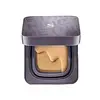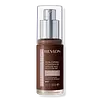Somethinc Copy Paste Breathable Mesh Cushion SPF 33 PA++ Versus Revlon Illuminance Skin-Caring Foundation
What's inside
What's inside
 Key Ingredients
Key Ingredients

 Benefits
Benefits

 Concerns
Concerns

 Ingredients Side-by-side
Ingredients Side-by-side

Water
Skin ConditioningTitanium Dioxide
Cosmetic ColorantCyclopentasiloxane
EmollientDiphenylsiloxy Phenyl Trimethicone
Skin ConditioningButylene Glycol
HumectantEthylhexyl Methoxycinnamate
UV AbsorberLauryl PEG-9 Polydimethylsiloxyethyl Dimethicone
Skin ConditioningDicaprylyl Carbonate
EmollientCyclohexasiloxane
EmollientCI 77492
Cosmetic ColorantGlycerin
HumectantCaprylic/Capric Triglyceride
MaskingTrimethylsiloxysilicate
EmollientPhenyl Trimethicone
Skin ConditioningPentylene Glycol
Skin ConditioningPolypropylsilsesquioxane
Synthetic Fluorphlogopite
PEG-10 Dimethicone
Skin ConditioningPhenoxyethanol
PreservativeMagnesium Sulfate
Dipentaerythrityl Hexa C5-9 Acid Esters
Skin ConditioningCI 77491
Cosmetic ColorantDimethicone
EmollientTriethoxycaprylylsilane
Dimethicone/Vinyl Dimethicone Crosspolymer
Skin ConditioningCI 77499
Cosmetic ColorantBetaine
HumectantPolyhydroxystearic Acid
EmulsifyingAluminum Hydroxide
EmollientDisteardimonium Hectorite
StabilisingStearic Acid
CleansingParfum
MaskingEthylhexylglycerin
Skin ConditioningLecithin
EmollientEthylhexyl Palmitate
EmollientIsostearic Acid
CleansingIsopropyl Myristate
EmollientHydrogenated Castor Oil Isostearate
Skin ConditioningPolyglyceryl-3 Polyricinoleate
EmulsifyingAnthemis Nobilis Flower Extract
MaskingDisodium EDTA
BHT
AntioxidantTocopherol
AntioxidantAllantoin
Skin ConditioningCaffeine
Skin Conditioning1,2-Hexanediol
Skin ConditioningWater, Titanium Dioxide, Cyclopentasiloxane, Diphenylsiloxy Phenyl Trimethicone, Butylene Glycol, Ethylhexyl Methoxycinnamate, Lauryl PEG-9 Polydimethylsiloxyethyl Dimethicone, Dicaprylyl Carbonate, Cyclohexasiloxane, CI 77492, Glycerin, Caprylic/Capric Triglyceride, Trimethylsiloxysilicate, Phenyl Trimethicone, Pentylene Glycol, Polypropylsilsesquioxane, Synthetic Fluorphlogopite, PEG-10 Dimethicone, Phenoxyethanol, Magnesium Sulfate, Dipentaerythrityl Hexa C5-9 Acid Esters, CI 77491, Dimethicone, Triethoxycaprylylsilane, Dimethicone/Vinyl Dimethicone Crosspolymer, CI 77499, Betaine, Polyhydroxystearic Acid, Aluminum Hydroxide, Disteardimonium Hectorite, Stearic Acid, Parfum, Ethylhexylglycerin, Lecithin, Ethylhexyl Palmitate, Isostearic Acid, Isopropyl Myristate, Hydrogenated Castor Oil Isostearate, Polyglyceryl-3 Polyricinoleate, Anthemis Nobilis Flower Extract, Disodium EDTA, BHT, Tocopherol, Allantoin, Caffeine, 1,2-Hexanediol
Water
Skin ConditioningCyclopentasiloxane
EmollientPhenyl Trimethicone
Skin ConditioningSqualane
EmollientPEG-10 Dimethicone
Skin ConditioningNeopentyl Glycol Diheptanoate
EmollientPropanediol
SolventPPG-24-Glycereth-24
EmulsifyingTrimethylsiloxysilicate
EmollientDimethicone
EmollientGlycerin
HumectantLecithin
EmollientMagnesium Sulfate
1,2-Hexanediol
Skin ConditioningAmmonium Acryloyldimethyltaurate/Vp Copolymer
C11-15 Alketh-40
CleansingC11-15 Pareth-7
EmulsifyingCamellia Sinensis Leaf Extract
AntimicrobialCaprylic/Capric Triglyceride
MaskingCaprylyl Glycol
EmollientDisteardimonium Hectorite
StabilisingEthylene/Acrylic Acid Copolymer
Emulsion StabilisingGlycyrrhiza Glabra Root Extract
BleachingHaematococcus Pluvialis Extract
AntioxidantLithospermum Erythrorhizon Root Extract
Skin ConditioningPEG/PPG-18/18 Dimethicone
EmulsifyingPolysilicone-11
Simethicone
EmollientSodium Hyaluronate
HumectantSodium Laureth-12 Sulfate
CleansingStyrene/Acrylates Copolymer
Tetrasodium EDTA
Tocopheryl Acetate
AntioxidantTriethoxycaprylylsilane
Triethyl Citrate
MaskingPhenoxyethanol
PreservativeCI 77163
Cosmetic ColorantCI 77491
Cosmetic ColorantCI 77492
Cosmetic ColorantCI 77499
Cosmetic ColorantCI 77891
Cosmetic ColorantWater, Cyclopentasiloxane, Phenyl Trimethicone, Squalane, PEG-10 Dimethicone, Neopentyl Glycol Diheptanoate, Propanediol, PPG-24-Glycereth-24, Trimethylsiloxysilicate, Dimethicone, Glycerin, Lecithin, Magnesium Sulfate, 1,2-Hexanediol, Ammonium Acryloyldimethyltaurate/Vp Copolymer, C11-15 Alketh-40, C11-15 Pareth-7, Camellia Sinensis Leaf Extract, Caprylic/Capric Triglyceride, Caprylyl Glycol, Disteardimonium Hectorite, Ethylene/Acrylic Acid Copolymer, Glycyrrhiza Glabra Root Extract, Haematococcus Pluvialis Extract, Lithospermum Erythrorhizon Root Extract, PEG/PPG-18/18 Dimethicone, Polysilicone-11, Simethicone, Sodium Hyaluronate, Sodium Laureth-12 Sulfate, Styrene/Acrylates Copolymer, Tetrasodium EDTA, Tocopheryl Acetate, Triethoxycaprylylsilane, Triethyl Citrate, Phenoxyethanol, CI 77163, CI 77491, CI 77492, CI 77499, CI 77891
 Reviews
Reviews

Ingredients Explained
These ingredients are found in both products.
Ingredients higher up in an ingredient list are typically present in a larger amount.
1,2-Hexanediol is a synthetic liquid and another multi-functional powerhouse.
It is a:
- Humectant, drawing moisture into the skin
- Emollient, helping to soften skin
- Solvent, dispersing and stabilizing formulas
- Preservative booster, enhancing the antimicrobial activity of other preservatives
This ingredient is an emollient, solvent, and texture enhancer. It is considered a skin-softener by helping the skin prevent moisture loss.
It helps thicken a product's formula and makes it easier to spread by dissolving clumping compounds.
Caprylic Triglyceride is made by combining glycerin with coconut oil, forming a clear liquid.
While there is an assumption Caprylic Triglyceride can clog pores due to it being derived from coconut oil, there is no research supporting this.
Learn more about Caprylic/Capric TriglycerideCi 77491 is also hydrated iron III oxide. It's sole purpose is to give a red/pink hue to products.
Iron III oxides are classified as inorganic chemicals for coloring.
Synthetically created Ci 77491 is considered safer than those naturally found. This is because the synthetically created version may contain less impurities. Iron oxides are generally non-toxic and non-allergenic.
Learn more about CI 77491Ci 77492 is also hydrated iron III oxide. It's sole purpose is to give a yellow hue to products.
Iron III oxides are classified as inorganic chemicals for coloring.
Synthetically created Ci 77492 is considered safer than those naturally found. This is because the synthetically created version may contain less impurities. Iron oxides are generally non-toxic and non-allergenic.
Learn more about CI 77492Ci 77499 is also hydrated iron III oxide. It is created from mixing red and black iron oxides. This helps give shades of darkness to a product.
Iron III oxides are classified as inorganic chemicals for coloring.
Cyclopentasiloxane, or D5, is a silicone used to improve texture of products and trap moisture.
D5 is considered lightweight and volatile. Volatile means it evaporates quickly after application. Once evaporated, D5 leaves a thin barrier that helps keep skin hydrated.
It is also an emollient. Emollients help soften the skin and prevent water loss. Silicones create a silky texture in products. D5 helps other ingredients become more spreadable.
Studies show D5 is safe to use in skincare products. We recommend speaking with a skincare professional if you have concerns.
Learn more about CyclopentasiloxaneDimethicone is a type of synthetic silicone created from natural materials such as quartz.
What it does:
Dimethicone comes in different viscosities:
Depending on the viscosity, dimethicone has different properties.
Ingredients lists don't always show which type is used, so we recommend reaching out to the brand if you have questions about the viscosity.
This ingredient is unlikely to cause irritation because it does not get absorbed into skin. However, people with silicone allergies should be careful about using this ingredient.
Note: Dimethicone may contribute to pilling. This is because it is not oil or water soluble, so pilling may occur when layered with products. When mixed with heavy oils in a formula, the outcome is also quite greasy.
Learn more about DimethiconeDisteardimonium Hectorite comes from the clay mineral named hectorite. It is used to add thickness to a product.
It can also help stabilize a product by helping to disperse other ingredients.
Hectorite is a rare, white clay mineral.
Learn more about Disteardimonium HectoriteGlycerin is already naturally found in your skin. It helps moisturize and protect your skin.
A study from 2016 found glycerin to be more effective as a humectant than AHAs and hyaluronic acid.
As a humectant, it helps the skin stay hydrated by pulling moisture to your skin. The low molecular weight of glycerin allows it to pull moisture into the deeper layers of your skin.
Hydrated skin improves your skin barrier; Your skin barrier helps protect against irritants and bacteria.
Glycerin has also been found to have antimicrobial and antiviral properties. Due to these properties, glycerin is often used in wound and burn treatments.
In cosmetics, glycerin is usually derived from plants such as soybean or palm. However, it can also be sourced from animals, such as tallow or animal fat.
This ingredient is organic, colorless, odorless, and non-toxic.
Glycerin is the name for this ingredient in American English. British English uses Glycerol/Glycerine.
Learn more about GlycerinLecithin is a term for a group of substances found in the cell membranes of plants, animals, and humans. They are made up of mixture of phospholipids.
This ingredient has emollient and emulsifying properties.
As an emollient, lecithen helps soften the skin and creates a barrier to keep moisture in.
As an emulsifier, it also helps prevent water and oil ingredients from separating. Lecithin can also help ingredients be better absorbed by the skin.
This is because the phospholipids in lecithin produce liposomes. Liposomes help other ingredients get through the skin barrier.
Depending on the source of this ingredient, lecithin may not be fungal acne safe. This is because some sources of lecithin come from soybean oil, which may feed the malassezia yeast that feeds fungal acne.
We recommend reaching out to the brand you are purchasing from to inquire about the source of their lecithin.
Some other names for this ingredient include soy lecithin and deoiled soy lecithin.
Learn more about LecithinMagnesium Sulfate is a salt. More specifically, it is an epsom salt, or the bath salt used to help relieve muscle aches.
Despite having ‘sulfate’ in the name, it isn’t a surfactant or cleansing agent like sodium lauryl sulfate. Unlike those sulfates, magnesium sulfate doesn’t have the same cleansing or foaming properties (it's simply a type of salt).
In cosmetics, Magnesium Sulfate is used to thicken a product or help dilute other solids. It is a non-reactive and non-irritating ingredient.
One study shows magnesium deficiency may lead to inflammation of the skin. Applying magnesium topically may help reduce inflammation.
You can find this ingredient in sea water or mineral deposits.
Learn more about Magnesium SulfatePeg-10 Dimethicone is silicone with conditioner and emulsifier properties. It mostly acts as an emollient in skincare and and humectant in haircare.
According to the manufacturer, acidic formulations decrease the stability of this ingredient. It works best in neutral or near neutral formulations.
Phenoxyethanol is a preservative that has germicide, antimicrobial, and aromatic properties. Studies show that phenoxyethanol can prevent microbial growth. By itself, it has a scent that is similar to that of a rose.
It's often used in formulations along with Caprylyl Glycol to preserve the shelf life of products.
Phenyl Trimethicone is a silicon-based polymer. It is derived from silica.
Phenyl Trimethicone is used as an emollient and prevents products from foaming.
As an emollient, it helps trap moisture in the skin. It is considered an occlusive.
Learn more about Phenyl TrimethiconeTriethoxycaprylylsilane is a silicone used to bind and stabilize ingredients.
As an emulsifier, it helps prevent ingredients from separating. This can help elongate the shelf life of products.
Triethoxycaprylylsilane is often used to coat mineral sunscreens ingredients to help give a better feel. It also helps reduce oxidative stress in sunscreens.
Learn more about TriethoxycaprylylsilaneThis silicone is an emollient. Emollients create a thin film on the skin to prevent moisture from escaping.
It is not soluble in water and helps increase water-resistance in products.
According to a manufacturer, it can blend seamlessly with silicone oils, such as Cyclopentasiloxane.
Learn more about TrimethylsiloxysilicateWater. It's the most common cosmetic ingredient of all. You'll usually see it at the top of ingredient lists, meaning that it makes up the largest part of the product.
So why is it so popular? Water most often acts as a solvent - this means that it helps dissolve other ingredients into the formulation.
You'll also recognize water as that liquid we all need to stay alive. If you see this, drink a glass of water. Stay hydrated!
Learn more about Water